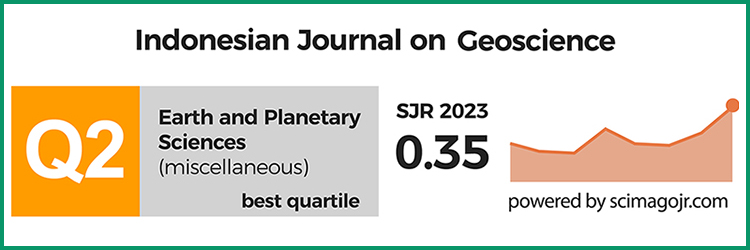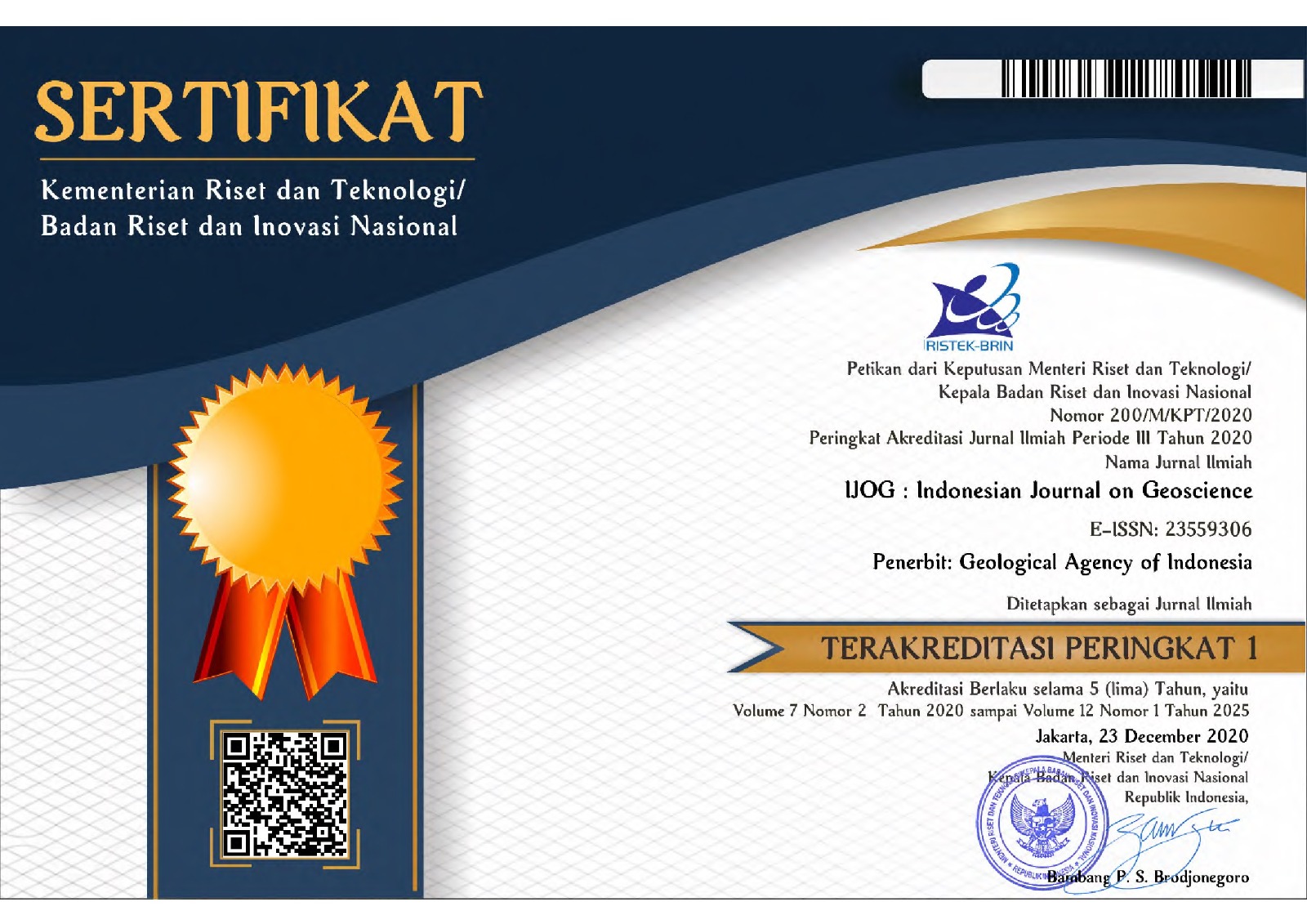Potential Development of Hydrocarbon in Basement Reservoirs In Indonesia
DOI:
https://doi.org/10.17014/ijog.8.3.151-161Keywords:
hydrocarbon, reservoir, basement rock, IndonesiaAbstract
Basement rocks, in particular igneous and metamorphic rocks are known to have porosity and permeability which should not be ignored. Primary porosity of basement rocks occurs as the result of rock formation. The porosity increases by the presence of cracks occurring as the result of tectonic processes (secondary porosity). Various efforts have been carried out to explore hydrocarbon in basement rocks. Some oil and gas fields proved that the basement rocks are as reservoirs which so far have provided oil and gas in significant amount. A review using previous research data, new data, and observation of igneous rocks in some fields has been done to see the development of exploration and basement reservoirs in Indonesia. A review on terminology of basement rock up till the identification of oil and gas exploration in basement rocks need to be based on the latest technology. An environmental approach is suggested to be applied as an alternative in analyzing the policy on oil and gas exploration development, especially in basement reservoirs.
References
Brahmantyo, B., 2007. Geologi Lingkungan dan Pengembangan Wilayah. Kelompok Keilmuan Geologi Terapan, Institut Teknologi Bandung.
Budiman, A. and Hendarsyah, 2007. Reservoir Geology of Fractured Basement in Suban Barat-1 Well - South Sumatra-Indonesia. Coordinating Committee for Geosciences Programmes in South East and Southeast Asia (CCOP), Seminar on Fractured Reservoir Exploration & Production,Hanoi - Vietnam, May 16-18 2007.
Caltex Pacific Indonesia, PT., 1995. Adendum Semdal Proyek Injeksi Air Lapangan Minyak Beruk Dalam Wilayah Minas Siak, Riau-Sumatra-Indonesia. Laporan Studi, Nopember 1995.
Cuong, T. X., et al, 2007. Main Factors Controling Quality of The Bach Ho Fractured Basement Reservoir. Coordinating Committee for Geosciences Programmes in South East and Southeast Asia (CCOP), Seminar on Fractured Reservoir Exploration & Production, Hanoi - Vietnam, May 16-18 2007.
Gutmanis, J., Batchelor, T., Cotton, L., and Baker, J. (Compilators), 2010. Hydrocarbon Production from Fractured Basements Formations. Geoscience Limited, 40 pp., https://.geoscience.co.uk/assets/file/reservoir.
Guttormsen, J. J., Wade, J. M., and Achita, R., 2008. Domain Based Geologic Modeling of A Fractured Granite Reservoir. Proceedings, Indonesian Petroleum Association, Thirty-Second Annual Convention & Exhibition.
Haans, A. and Usman, 2010. Pengembangan Simulasi Distribusi Rekahan pada Reservoir Rekah Alami Berdasarkan Data Produksi. Lembaran Publikasi LEMIGAS, 44 (3), p. 246 - 252. ISSN: 0125-9644.
Hadipandoyo, S., Setyoko, H. J., Suliantara, Guntur, A., Hartanto, H.S., Harahap, M.D., and Firdaus, N, 2007. Kuantifikasi Sumberdaya Hidrokarbon Indonesia. PPPTMGB LEMIGAS, 318 p. ISBN 978.979-8218-16-3.
Hennings, P.H., Allwardt, P.F., Paul, P.K., Zahm, C.K., Reid, R., Alley, H., Kirschner, R, Lee, B., and Hough, E., 2012. Relationship between fractures, fault zones, stress, and reservoir productivity in the Suban gas field, Sumatra, Indonesia. American Association of Petroleum Geologist, Bulletin, 96, p.753-772. doi:10.1306/08161109084
Koesoemadinata, R.P., 2008. Petroleum Basins of Indonesia, The Development of Basins in Indonesia. Institut Teknologi Bandung - BP MIGAS - IAGI, Bandung.
Koning, T. and Darmono, F.X., 1984. The geology of the Beruk Northeast Field, Central Sumatra: Oil production from Pre-Tertiary basement rocks. Proceedings of the 14th IPA Annual Convention, Jakarta, p.117-137.
Lelono, E.B. et al., 2010. Paleogeografi dan Potensi Hidrokarbon Cekungan Frontier Sula, Maluku Utara. Kementerian ESDM, Badan Litbang ESDM, LEMIGAS, 2010 (Tidak dipublikasikan).
LEMIGAS, 2009. Kamus Minyak dan Gas Bumi. Edisi Keenam. Pusat Penelitian dan Pengembangan Teknologi Minyak dan Gas Bumi “LEMIGAS”, 546 pp. ISBN 979-825-12-4.
Passchier, C. W. and Trouw, R.A.J., 1996. Microtectonics. Springer - Verlag Berlin Hedelberg New York, ISBN 3-540-58713-6, 289 pp. doi:10.1093/petroj/38.7.971-b
Petford, N. and McCaffrey, K., 2003. Hydrocarbons in crystalline rocks: an introduction. Geological Society. London, Special Publication, 214, p.1-5, 0305-8719/03/S15. doi:10.1144/GSL.SP.2003.214.01.01
Ruswandi, A., 2011. Proyek Percontohan Penemuan Cadangan Tight Shale Gas Reservoir. PPPTMGB LEMIGAS (Tidak dipublikasikan).
Satyana, A. H., 1995. The Northern Massifs of The Meratus Mountains, South Kalimantan: Nature, Evolution, and Tectonic Implications to The Barito Structures. Proceedings Vol I PIT-IAGI, Jakarta, p.457-470.
Trilangga, A., dan Anggoro, S.D., 2012, Pengaruh Tekanan Pori Terhadap Kekuatan Rekah (Effective Stress) dari Manusela Carbonate Reservoir pada Fracturing Sumur E.Nief-1. Proceedings, PIT IAGI Yogyakarta 2012, The 41st IAGI Annual Convention and Exhibition.
Whitten D.G.A. and Brooks, J.R.V., 1978. The Penguin Dictionary of Geology. Penguin Books Ltd, Harmondsworth, Middlesex, England, 493 pp. ISBN 014051.04.2 doi:10.1017/S0016756800048068
Yuwono, Y.S., 2012. Basic Concept, Principles, and Petrologic Assessments. Short Course on the Basement Reservoir, Yogyakarta, 14-16 June 2012.



















